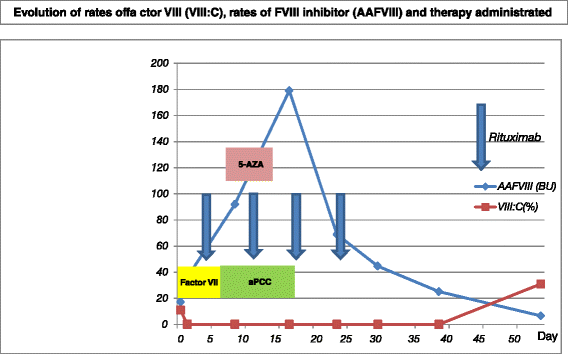Myelofibrosis and acquired hemophilia A: a case report
- PMID: 27154067
- PMCID: PMC4859983
- DOI: 10.1186/s13256-016-0897-4
Myelofibrosis and acquired hemophilia A: a case report
Abstract
Background: Myelofibrosis and acquired hemophilia A is a rare association. To the best of our knowledge only one case of myelofibrosis and acquired hemophilia A has been previously described.
Case presentation: A 66-year-old Caucasian man diagnosed with myelofibrosis evolving in acute myeloid leukemia was referred to us for postoperative bleeding. Hemostatic studies showed prolonged activated partial thromboplastin time, decreased factor VIII coagulation, and a high factor VIII inhibitor titer; these findings led to a diagnosis of acquired hemophilia A for which he was treated with methylprednisolone and recombinant activated factor VII on admission. Due to a lack of response he was subsequently treated with rituximab combined with activated prothrombin complex concentrates. Furthermore, he received azacytidine to treat the underlying hematological malignancies. Immunosuppressive rituximab therapy resolved acquired hemophilia A with marked efficacy.
Conclusions: Rapid and accurate diagnosis, effective hemostatic therapy, and timely treatment for underlying disease are important in the management of acquired hemophilia A secondary to hematological malignancy.
Keywords: Acquired hemophilia A; Activated prothrombin complex concentrates; Azacytidine; Myelofibrosis; Rituximab.
Figures

References
-
- Baudo F, De Cataldo F. Acquired hemophilia: a critical bleeding syndrome. Haematologica. 2004;89:96–100. - PubMed
-
- Jacobson RJ, Salo A, Fialkow PJ. Agnogenic myeloid metaplasia: a clonal proliferation of hematopoietic stem cells with secondary myelofibrosis. Blood. 1978;51:189–94. - PubMed
-
- Barosi G. Myelofibrosis with myeloid metaplasia: diagnostic definition and prognostic classification for clinical studies and treatment guidelines. J Clin Oncol. 1999;17(9):2954–70. - PubMed
Publication types
MeSH terms
Substances
Supplementary concepts
LinkOut - more resources
Full Text Sources
Other Literature Sources
Medical

